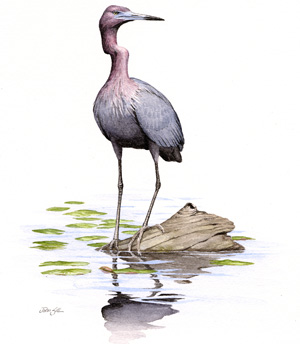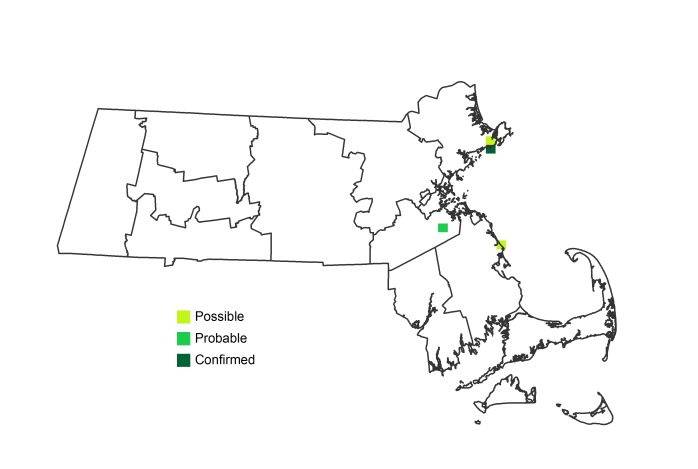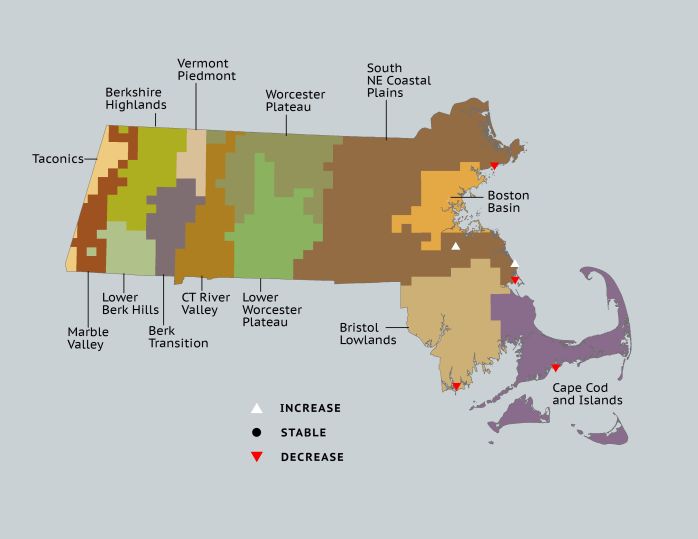Find a Bird
Little Blue Heron
Egretta caerulea

Very local, trend not established
“It moves actively about in search of these, sometimes making a run at its prey; and is often seen in company with the Snowy Heron, figured in the same plate. Like this last, it is also very silent, intent, and watchful.” – Alexander Wilson, American Ornithology
The Little Blue Heron was never hunted as extensively for its plumes as many of the other herons were, but because it prefers to breed in colonies with more “valuable” species, it still suffered from intense human disturbance. Little Blue Herons are calm, patient, and often solitary hunters. They can often be seen walking slowly through freshwater, estuarine, and marine wetlands, methodically peering below the surface in search of food. They most often feed alone, or occasionally with members of their own species. This avian xenophobia does not extend to their breeding grounds; however, they will readily join herons and egrets of other species in nesting colonies.
Historic Status
Little Blue Herons did not often catch the eye of Massachusetts birders until the second decade of the twentieth century. A gunner in Cohasset took one in 1852 (Howe 1901), but a number of other records are sparse and often unreliable, resulting from confusion of Little Blue Herons in their immature plumage with Snowy Egrets. Despite the fact that they were not targeted during the great millinery massacres of the late nineteenth century – the period during which the Audubon movement spread across the country – Little Blue Herons certainly were still the victims of collateral damage. The banning of the plume trade freed the birds to roam, and, during the seven-year period from 1917 to 1923, Forbush noted a marked increase in this species in Massachusetts (Forbush 1925). The first nesting in the state occurred in Marshfield in 1940, but it wasn’t until the 1970s that the species became firmly established in the state (Petersen & Meservey 2003).
Atlas 1 Distribution
Though Little Blue Herons may have been plentiful in the southeastern US, few made it far enough north to breed in the Bay State during Atlas 1. The Coastal Plains accounted for 2 out of 4 occupied blocks, and all records came from existing heronries composed mostly of other species, such as Snowy Egrets and Black-crowned Night-Herons. The colony at House Island at one time hosted as many as 15 pairs of Little Blue Herons, and another half-dozen or so pairs appeared at Big Ram Island in the Bristol/Narragansett Lowlands, and 10 more adults were found at Sampsons Island in the Cape and Islands region. Difficulty in separating the white-plumaged young from those of nearby Snowy Egrets may have made young Little Blue Herons sometimes difficult to keep track of during Atlas 1.
Atlas 2 Distribution and Change
Even if that ancient Massachusetts tradition of Snowy Egret versus Little Blue misidentification continued into Atlas 2, it would be hard to accept this as the explanation for the apparent decline in breeding Little Blue Herons, although their distribution saw no net change. It is more likely that since the species is at the extreme end of its northern range, it will always be considered an oddity as far as breeding in Massachusetts goes. Global climate change could challenge that notion in the coming years, though that remains to be seen.
Atlas 1 Map

Atlas 2 Map

Atlas Change Map

Ecoregion Data
Atlas 1 | Atlas 2 | Change | ||||||
Ecoregion | # Blocks | % Blocks | % of Range | # Blocks | % Blocks | % of Range | Change in # Blocks | Change in % Blocks |
Taconic Mountains | 0 | 0.0 | 0.0 | 0 | 0.0 | 0.0 | 0 | 0.0 |
Marble Valleys/Housatonic Valley | 0 | 0.0 | 0.0 | 0 | 0.0 | 0.0 | 0 | 0.0 |
Berkshire Highlands | 0 | 0.0 | 0.0 | 0 | 0.0 | 0.0 | 0 | 0.0 |
Lower Berkshire Hills | 0 | 0.0 | 0.0 | 0 | 0.0 | 0.0 | 0 | 0.0 |
Vermont Piedmont | 0 | 0.0 | 0.0 | 0 | 0.0 | 0.0 | 0 | 0.0 |
Berkshire Transition | 0 | 0.0 | 0.0 | 0 | 0.0 | 0.0 | 0 | 0.0 |
Connecticut River Valley | 0 | 0.0 | 0.0 | 0 | 0.0 | 0.0 | 0 | 0.0 |
Worcester Plateau | 0 | 0.0 | 0.0 | 0 | 0.0 | 0.0 | 0 | 0.0 |
Lower Worcester Plateau | 0 | 0.0 | 0.0 | 0 | 0.0 | 0.0 | 0 | 0.0 |
S. New England Coastal Plains and Hills | 2 | 0.7 | 50.0 | 4 | 1.4 | 100.0 | 0 | 0.0 |
Boston Basin | 0 | 0.0 | 0.0 | 0 | 0.0 | 0.0 | 0 | 0.0 |
Bristol and Narragansett Lowlands | 1 | 0.9 | 25.0 | 0 | 0.0 | 0.0 | -1 | -1.0 |
Cape Cod and Islands | 1 | 0.7 | 25.0 | 0 | 0.0 | 0.0 | -1 | -0.8 |
Statewide Total | 4 | 0.4 | 100.0 | 4 | 0.4 | 100.0 | -2 | -0.2 |
Notes
Little Blue Herons show a significant decreasing Breeding Bird Survey trend in the eastern US region.



